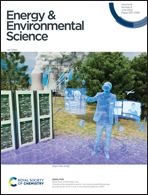Carbide-mediated catalytic hydrogenolysis: defects in graphene on a carbonaceous lithium host for liquid and all-solid-state lithium metal batteries†
Abstract
Lithium metal is the most promising anode for next-generation lithium batteries. Nonetheless, its non-uniform Li nucleation, dendritic growth, and infinite volume variation lead to rapid cell failure and hinder its practical application. Here, we propose a defective graphene shell grown on a carbon matrix as a stable lithium metal host via carbide-mediated catalytic hydrogenolysis. It has numerous nano-channels with defective graphene shells on its surface, which can effectively guide the dendrite-free Li deposition and accommodate a rational amount of metallic Li without severe cell volume change. Due to these features, the host exhibits good cycle stability (87.2% after 500 cycles) and low dimension variation (9 μm) in carbonate electrolyte full-cell evaluations. In addition to its good performances in the carbonate electrolyte, our versatile Li host, acting as a Li-ion flux regulating interlayer, also achieves an improved cycling performance in the argyrodite Li6PS5Cl based high energy density all-solid-state battery full-cell configuration.



 Please wait while we load your content...
Please wait while we load your content...